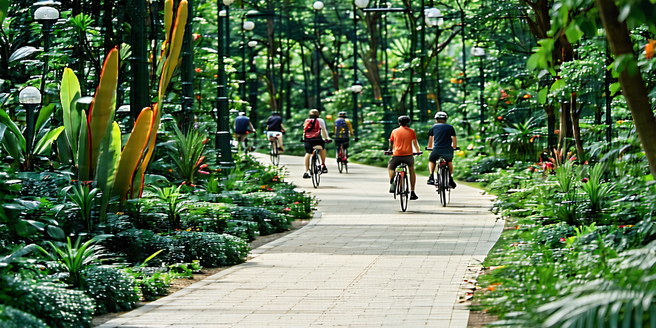
Benefits of Urban Green Spaces
Urban green spaces contribute significantly to the well-being of city residents. They provide a refuge from the bustling urban environment, allowing people to connect with nature. These spaces promote physical activities like walking and jogging, which are critical for maintaining health. Additionally, urban greenery has been shown to improve air quality by filtering pollutants and reducing heat through shade and transpiration. Socially, green spaces offer places for community gatherings, enhancing social cohesion and interaction. Mental health also benefits, as exposure to natural settings can reduce stress and improve mood. Considering the escalating urbanization, integrating more green spaces in cities is crucial to creating healthier urban living conditions. It’s vital for city planners and policymakers to prioritize the development and maintenance of these vital areas.
Designing Sustainable Green Spaces
Designing green spaces sustainably involves considering environmental impacts and promoting biodiversity. Planners should use native plant species to reduce the need for water and maintenance while supporting local ecosystems. Creating multi-functional spaces that serve ecological and social purposes can enhance their utility and resilience. Incorporating elements such as rain gardens can help manage stormwater, reducing the burden on urban drainage systems. Sustainable design also involves ensuring accessibility for all, fostering inclusivity. Renewable energy sources, like solar lighting, can be utilized to minimize the carbon footprint. It’s essential to engage with the community to understand local needs and incorporate them into the design. Thoughtfully designed urban green spaces can act as vital infrastructure that offers ecological benefits while contributing to the residents’ quality of life.
Community Engagement in Green Space Planning
Community engagement is a fundamental aspect of effective green space planning. It involves the participation of local residents in the decision-making process, ensuring the spaces meet their needs and preferences. Engagement can take various forms, such as workshops, surveys, and public forums, allowing for diverse input. By involving the community, planners can identify which features and amenities are most valued, leading to more successful and well-used spaces. This participatory approach also fosters a sense of ownership and stewardship among residents, encouraging them to care for the spaces. Additionally, community engagement helps to address potential conflicts and align green space projects with cultural and social contexts. The collaboration between planners and residents can result in innovative solutions that enhance sustainability and social cohesion.
Innovative Green Space Solutions
Innovative solutions in green space development are transforming urban landscapes. One approach is the integration of vertical gardens and green roofs, which maximize limited space and improve air quality. Another is the development of green corridors that connect isolated areas, facilitating wildlife movement and increasing biodiversity. Digital technology plays a role through smart green infrastructure, where sensors can monitor environmental conditions, improving maintenance and resource allocation. Pop-up parks are temporary installations that transform underutilized spaces and engage the community. Utilizing recycled and sustainable materials in construction can reduce environmental impacts. These innovations require collaboration between various stakeholders, ensuring that technological advancements align with community needs. By embracing creativity and innovation, cities can enhance the accessibility and functionality of urban green spaces, contributing to a more sustainable urban future.
Challenges in Urban Green Space Development
Developing urban green spaces presents several challenges. Limited land availability in densely populated areas makes it difficult to find suitable locations for parks and green areas. Financial constraints can also hinder the development and maintenance of these spaces, as funding priorities may lean towards other infrastructure needs. Ensuring equitable access to green spaces is another challenge, as socio-economic disparities can lead to unequal distribution. Environmental concerns, like soil contamination in former industrial sites, add complexity to development projects. Balancing the needs of diverse stakeholders, including residents, businesses, and government entities, can also pose difficulties. Moreover, climate change impacts, such as extreme weather events, can threaten the sustainability of green spaces. Addressing these challenges requires innovative planning, strategic investment, and collaboration among all involved parties.
Future Trends in Urban Green Spaces
The future of urban green spaces is evolving with emerging trends set to shape their development. One trend is the integration of technology, such as smart systems for irrigation and lighting that enhance efficiency. There is also a growing focus on creating multi-functional spaces that support environmental, social, and economic goals simultaneously. The rise of community-driven urban farming on green spaces offers local food production opportunities and strengthens food security. Anticipating climate change effects, future green spaces will likely incorporate resilient designs to withstand extreme weather. Integrating arts and culture into green space planning is another trend that can enhance regional identity and attract visitors. Overall, urban green spaces will continue to adapt, addressing environmental challenges while improving urban livability for diverse populations.
